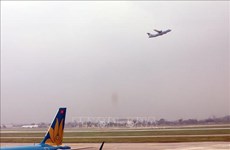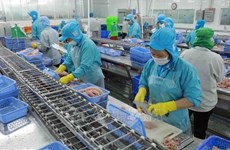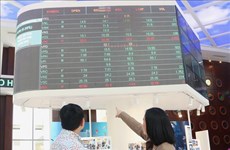Agricultural sector fails to attract FDI
In the last 10 years, foreign direct investment (FDI) in the
agriculture sector has dropped from 8 percent in 2001 to 1 percent in
2010, leading some to ask what has led to such a steep decline in the
country's primary industry.
In the last 10 years, foreign direct investment (FDI) in the
agriculture sector has dropped from 8 percent in 2001 to 1 percent in
2010, leading some to ask what has led to such a steep decline in the
country's primary industry.
Tran Van Cong, Director of the Division of Global Integration and Investment, an affiliate of the International Co-operation Department (ICD) under the Ministry of Agriculture and Rural Development, cited three reasons for the situation.
First, the transfer of all agricultural and animal feed projects to the industrial sector. Second, the rapid increase of FDI going to infrastructure and real estate projects while agricultural sector investment has remained the same.
And third, investment in agriculture is risky, as production depends so heavily on natural conditions, while the depreciation period is long.
In his opinion, an objective look at the development strategy to attract more FDI for the agricultural sector should be taken, along with creating conditions to facilitate FDI investors to operate in the country.
Last year, about 20 Republic of Korea (RoK) businesses came to Vietnam to inquire about the country's policies and investment climate in the agriculture sector, particularly in the agro processing industry and agricultural machinery.
But so far, FDI coming from the RoK remains very modest.
A representative from the Korean Investment and Trade Promotion Centre in Vietnam (Kotra) said openly that it is not lucrative to invest in the agricultural sector, mainly because of the shortage of information, poor infrastructure and cumbersome administrative procedures.
In addition, preferential policies given to investors in agriculture have been given poor ratings by investors. In 2010, the Government issued Decree 61/2010/ND-CP to offer more incentives to investors in agriculture, yet only 1.63 percent of investors poured money into the industry.
Dr Dang Kim Son, Director General of the Institute of Policy for Agriculture and Rural Development (IPSARD) said: "Even Vietnamese investors do not want to invest in the agriculture industry."
"Rich people in rural areas have invested in urban development elsewhere. So how can we attract foreign investors to invest in our agriculture sector?" Son asked.
Cong said that in 2011, his ministry would make efforts to attract FDI in projects using fewer natural resources. Instead, focus would be given to projects using high technology, the processing industry, and agricultural machinery.
To attract more FDI, the Ministry of Agriculture and Rural Development (MARD) has studied the private-public partnership model in a hope to create a breakthrough for the country's primary industry.
At present, capital investment in the agricultural sector is very modest – with a sum of somewhere between 20-30 million USD. Investors in high tech projects come primarily from Thailand , the RoK, Japan and Singapore while only a few come from either Europe or America .
Tran Kim Long, Deputy Director General of the ICD said the agriculture sector had tried to use successful official development assistance (ODA) projects as an example to lure more FDI.
In 2010, ODA investment in the industry reached a record 490 million USD in 32 projects.
Twelve of the projects focused on building new rural lifestyles while the rest were for livestock and cultivation, production, forestry conservation, irrigation and climate change. /.
Tran Van Cong, Director of the Division of Global Integration and Investment, an affiliate of the International Co-operation Department (ICD) under the Ministry of Agriculture and Rural Development, cited three reasons for the situation.
First, the transfer of all agricultural and animal feed projects to the industrial sector. Second, the rapid increase of FDI going to infrastructure and real estate projects while agricultural sector investment has remained the same.
And third, investment in agriculture is risky, as production depends so heavily on natural conditions, while the depreciation period is long.
In his opinion, an objective look at the development strategy to attract more FDI for the agricultural sector should be taken, along with creating conditions to facilitate FDI investors to operate in the country.
Last year, about 20 Republic of Korea (RoK) businesses came to Vietnam to inquire about the country's policies and investment climate in the agriculture sector, particularly in the agro processing industry and agricultural machinery.
But so far, FDI coming from the RoK remains very modest.
A representative from the Korean Investment and Trade Promotion Centre in Vietnam (Kotra) said openly that it is not lucrative to invest in the agricultural sector, mainly because of the shortage of information, poor infrastructure and cumbersome administrative procedures.
In addition, preferential policies given to investors in agriculture have been given poor ratings by investors. In 2010, the Government issued Decree 61/2010/ND-CP to offer more incentives to investors in agriculture, yet only 1.63 percent of investors poured money into the industry.
Dr Dang Kim Son, Director General of the Institute of Policy for Agriculture and Rural Development (IPSARD) said: "Even Vietnamese investors do not want to invest in the agriculture industry."
"Rich people in rural areas have invested in urban development elsewhere. So how can we attract foreign investors to invest in our agriculture sector?" Son asked.
Cong said that in 2011, his ministry would make efforts to attract FDI in projects using fewer natural resources. Instead, focus would be given to projects using high technology, the processing industry, and agricultural machinery.
To attract more FDI, the Ministry of Agriculture and Rural Development (MARD) has studied the private-public partnership model in a hope to create a breakthrough for the country's primary industry.
At present, capital investment in the agricultural sector is very modest – with a sum of somewhere between 20-30 million USD. Investors in high tech projects come primarily from Thailand , the RoK, Japan and Singapore while only a few come from either Europe or America .
Tran Kim Long, Deputy Director General of the ICD said the agriculture sector had tried to use successful official development assistance (ODA) projects as an example to lure more FDI.
In 2010, ODA investment in the industry reached a record 490 million USD in 32 projects.
Twelve of the projects focused on building new rural lifestyles while the rest were for livestock and cultivation, production, forestry conservation, irrigation and climate change. /.











